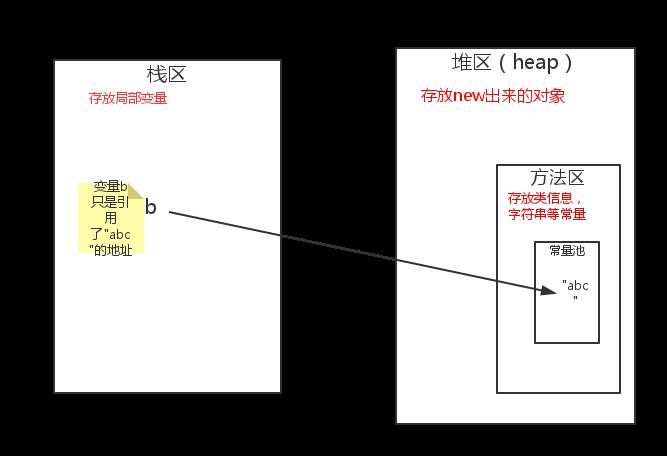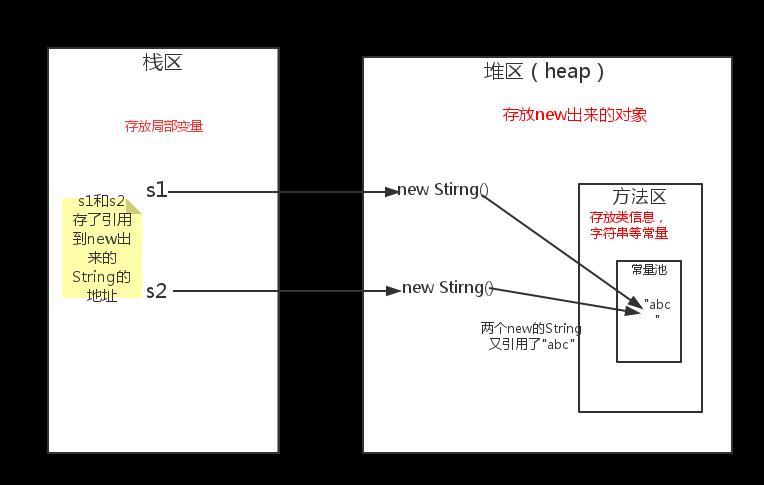Java你可能不知道的事系列1
Posted So,Cool
tags:
篇首语:本文由小常识网(cha138.com)小编为大家整理,主要介绍了Java你可能不知道的事系列1相关的知识,希望对你有一定的参考价值。
概述
本类文章会不段更新分析学习到的经典面试题目,在此记录下来便于自己理解。如果有不对的地方还请各位观众拍砖。
今天主要分享一下常用的字符串的几个题目,相信学习java的小伙伴们对String类是再熟悉不过了,今天我们就来和她再次邂逅,好了下面开始。
先来说说String特点
String是不可变的常量,每当我们创建一个字符串对象的时候,如果堆区的常量池里不存在这个字符串,就会创建一个存储在常量池里(String存的地方叫String pool),如果存在了,就直接把变量的地址指向常量池里,比如:String b = “abc” 这句话 内存表示如下。下面开始上题 
1.1
String s1 = new String("abc");
String s2 = new String("abc");
System.out.println(s1 == s2);输出结果是什么呢?
从上面的图也大概说了jvm里面有堆、栈区。堆区里面主要存放的是局部变量,栈区里存放的是new出来的对象。==对于对象类型比较的是地址。所以在s1和s1是分别引用了堆里面new出来的不同对象的地址,图形理解如下

答案很明显了,地址不同 输出false.
1.2
String s1 = "abc";
StringBuffer s2 = new StringBuffer(s1);
System.out.println(s1.equals(s2));这是true 还是false呢?答案是false。
首先s1变量引用了字符串”abc”,然后StringBuffer s2 = new StringBuffer(s1),新建了一个StringBuffer对象调用append()方法返回自身。调用String的equals方法。重点就是这个equals方法里有个instance of,必需是同一类型的才进行比较否则直接返回false。
来看一下源码:
/**
* Compares this string to the specified object. The result is {@code
* true} if and only if the argument is not {@code null} and is a {@code
* String} object that represents the same sequence of characters as this
* object.
*
* @param anObject
* The object to compare this {@code String} against
*
* @return {@code true} if the given object represents a {@code String}
* equivalent to this string, {@code false} otherwise
*
* @see #compareTo(String)
* @see #equalsIgnoreCase(String)
*/
public boolean equals(Object anObject) {
if (this == anObject) {
return true;
}
//关键点就在这里了
if (anObject instanceof String) {
String anotherString = (String) anObject;
int n = value.length;
if (n == anotherString.value.length) {
char v1[] = value;
char v2[] = anotherString.value;
int i = 0;
while (n-- != 0) {
if (v1[i] != v2[i])
return false;
i++;
}
return true;
}
}
return false;
}1.3
下面的代码在内存会产生几个对象呢?
String s1 = new String(“abc”);
String s2 = new String(“abc”);
答案:3个
有了上面的分析,相信大家都明白了,new了两个对象,加上string pool里的一个”abc”。
1.4
下面的代码输出结果是啥?
String s1 = "abc";
String s2 = new String("abc");
s2.intern();
System.out.println(s1 ==s2);我们可能对intern()这个方法不太熟悉,先来看看注释:
/**
* Returns a canonical representation for the string object.
* <p>
* A pool of strings, initially empty, is maintained privately by the
* class <code>String</code>.
* <p>
* When the intern method is invoked, if the pool already contains a
* string equal to this <code>String</code> object as determined by
* the {@link #equals(Object)} method, then the string from the pool is
* returned. Otherwise, this <code>String</code> object is added to the
* pool and a reference to this <code>String</code> object is returned.
* <p>
* It follows that for any two strings <code>s</code> and <code>t</code>,
* <code>s.intern() == t.intern()</code> is <code>true</code>
* if and only if <code>s.equals(t)</code> is <code>true</code>.
* <p>
* All literal strings and string-valued constant expressions are
* interned. String literals are defined in section 3.10.5 of the
* <cite>The Java™ Language Specification</cite>.
*
* @return a string that has the same contents as this string, but is
* guaranteed to be from a pool of unique strings.
*/
public native String intern();注释好多我草,关键的是这句:When the intern method is invoked, if the pool already contains a string equal to this String object as determined by
the {@link #equals(Object)} method, then the string from the pool is
returned. Otherwise, this String object is added to the
pool and a reference to this String object is returned.
大致就是说,如果常量池里不存在这个字符串,就创建一个并且返回地址,否则的话直接返回地址。
上面的代码第二行String s2 = new String(“abc”); s2其实是引用到了new的对象,虽然在第三行调用了intern方法,但是没有赋值给s2,所以s2的引用还是没有变。所以返回false。
如果第三行代码改成s2 = s2.intern()就会返回true了。
String s1 = "abc";
String s2 = new String("abc");
s2 = s2.intern();
System.out.println(s1==s2);好了,今天就到这里。之后会继续分析。如果喜欢我的文章欢迎关注我。各位看官大爷的支持是我最大的动力!!
以上是关于Java你可能不知道的事系列1的主要内容,如果未能解决你的问题,请参考以下文章